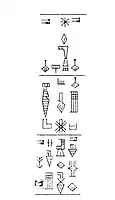Shu-turul
Shu-turul (Shu-durul, 𒋗𒄙𒄒, shu-tur2-ul3)[1][2] was the last king of the Akkadian Empire, ruling for 15 years according to the Sumerian king list.[3] It indicates that he succeeded his father Dudu. A few artifacts, seal impressions etc. attest that he held sway over a greatly reduced Akkadian territory that included Kish, Tutub, and Eshnunna. The Diyala river also bore the name "Shu-durul" at the time.[4]
| Shu-turul | |
|---|---|
| |
 The name "Shu-turul" (𒋗𒄙𒄒, shu-tur2-ul3) on the macehead inscription, with transcription in standard Sumero-Akkadian cuneiform. | |
| King of the Akkadian Empire | |
| Reign | c. 2168 BC – 2154 BC |
| Predecessor | Dudu |
| Successor | Gutian Dynasty |
| Father | Dudu of Akkad |
Sumerian King List
The king list asserts that Akkad was then conquered, and the hegemony returned to Uruk following his reign.[5] It further lists six names of an Uruk dynasty; however none of these six rulers has been confirmed through archaeology. The actual situation of Akkad's collapse, from all evidence outside the king list, is that it was brought about directly by the Gutians, Zagros tribesmen who established their own rule, though several of the southern city-states such as Uruk, Ur and Lagash also declared independence around this time.
Inscriptions
A few inscriptions in his name are known.[6] One reads:
"Šu-Turul the mighty, king of Agade"
— Shu-turul inscription[7]
A votive mace[8][9] is also known with an inscription mentioning Shu-turul and the dedication of a temple to Nergal:
Votive mace of Shu-turul, with illustration of the inscription in his name on the flange (reconstiution). Room 56, display case 11, British Museum[10][9]𒀀𒈾 𒀭𒊊𒀕𒃲 𒀀𒈾 𒈾𒂍𒋛 𒋗𒄙𒄒 𒈗𒌷 𒀀𒂵𒉈𒆠 𒆷𒁀?𒋳 𒉺𒀠𒂍 𒀀𒈬𒊒
a-na {d}ne3-iri11-gal a-na na-'a3-si szu-tur2-ul3 szar3-ri2 a-ga-de3{ki} la-ba-'a3?-szum szabra e2 a mu-ru"To Nergal, for the life of Shu-turul king of Akkad, Laba-erishum the palace soothsayer has dedicated this"

 The Gutians ended the reign of Shu-turul. 19th century illustration.
The Gutians ended the reign of Shu-turul. 19th century illustration. Shu-turul in the Akkadian family tree
Shu-turul in the Akkadian family tree
External links
Sources
- "Sumerian Dictionary". oracc.iaas.upenn.edu.
- Gadd, C. J. (Cyril John) (1921). The early dynasties of Sumer and Akkad. London, Luzac & co. p. Plate III, BM 114703.
- Handbook To Life In Ancient Mesopotamia by Stephen Bertman
- Donald M. Matthews, The Early Glyptic of Tell Brak: Cylinder Seals of Third Millennium Syria 1997, p. 15.
- Who's Who in the Ancient Near East by Gwendolyn Leick
- "CDLI-Found Texts". cdli.ucla.edu.
- "CDLI-Archival View". cdli.ucla.edu.
- "BM 114703".
- "Shu-turul mace". British Museum.
- "BM 114703".
- "CDLI-Archival View". cdli.ucla.edu.
- "BM 114703".
- Pognon (January 1913). "Journal asiatique : ou recueil de mémoires, d'extraits et de notices relatifs à l'histoire, à la philosophie, aux sciences, à la littérature et aux langues des peuples orientaux... / publié par la Société asiatique". Gallica: 418–430.
| Regnal titles | ||
|---|---|---|
| Preceded by Dudu |
King of Akkad King of Kish, Uruk, Lagash, and Umma Overlord of Elam ca. 2168 – 2154 BCE (Middle) |
Succeeded by ---- (Gutian Dynasty) |
.jpg.webp)